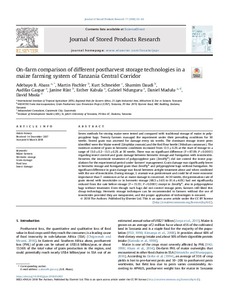| dc.contributor.author | Abass, A.B. |
| dc.contributor.author | Fischler, M. |
| dc.contributor.author | Schneider, K. |
| dc.contributor.author | Daudi, S. |
| dc.contributor.author | Gaspar, A. |
| dc.contributor.author | Rüst, J. |
| dc.contributor.author | Kabula, E. |
| dc.contributor.author | Ndunguru, G. |
| dc.contributor.author | Madulu, D. |
| dc.contributor.author | Msola, D. |
| dc.date.accessioned | 2019-12-04T11:18:27Z |
| dc.date.available | 2019-12-04T11:18:27Z |
| dc.date.issued | 2018-06 |
| dc.identifier.citation | Abass, A. B., Fischler, M., Schneider, K., Daudi, S., Gaspar, A., Rüst, J., ... & Msola, D. (2018). On-farm comparison of different postharvest storage technologies in a maize farming system of Tanzania Central Corridor. Journal of Stored Products Research, 77, 55-65. |
| dc.identifier.issn | 0022-474X |
| dc.identifier.uri | https://hdl.handle.net/20.500.12478/3209 |
| dc.description | Article purchased; Published online: 16 March 2018 |
| dc.description.abstract | Seven methods for storing maize were tested and compared with traditional storage of maize in polypropylene bags. Twenty farmers managed the experiment under their prevailing conditions for 30 weeks. Stored grain was assessed for damage every six weeks. The dominant storage insect pests identified were the Maize weevil (Sitophilus zeamais) and the Red flour beetle (Tribolium castaneum). The moisture content of grain in hermetic conditions increased from 12.5 ± 0.2% at the start of storage to a range of 13.0 ± 0.2–13.5 ± 0.2% at 30 weeks. There was no significant difference (F = 87.09; P < 0.0001) regarding insect control and grain damage between hermetic storage and fumigation with insecticides. However, the insecticide treatment of polypropylene yarn (ZeroFly®) did not control the insect populations for the experimental period under farmers' management. Grain damage was significantly lower in hermetic storage and fumigated grain than ZeroFly® and polypropylene bags without fumigation. No significant difference in grain damage was found between airtight treatment alone and when combined with the use of insecticides. During storage, S. zeamais was predominant and could be of more economic importance than T. castaneum as far as maize damage is concerned. At 30 weeks, the germination rate of grain stored with insecticides or in hermetic storage (68.5 ± 3.6% to 81.4 ± 4.0%) had not significantly reduced from the rate before storage (F = 15.55; P < 0.0001) except in ZeroFly®, also in polypropylene bags without treatment. Even though such bags did not control storage pests, farmers still liked this cheap technology. Hermetic storage techniques can be recommended to farmers without the use of insecticides provided they are inexpensive, and the proper application of technologies is ensured. |
| dc.description.sponsorship | Swiss Agency for Development and Cooperation |
| dc.description.sponsorship | United States Agency for International Development |
| dc.format.extent | 55-65 |
| dc.language.iso | en |
| dc.subject | Maize |
| dc.subject | Farmers |
| dc.subject | Storage |
| dc.subject | Grain |
| dc.subject | Damage |
| dc.subject | Postharvest Technology |
| dc.subject | Hermetic Storage |
| dc.subject | Grain Damage |
| dc.subject | Food Loss |
| dc.subject | Insect Damage |
| dc.subject | Farming Systems |
| dc.title | On-farm comparison of different postharvest storage technologies in a maize farming system of Tanzania Central Corridor |
| dc.type | Journal Article |
| dc.description.version | Peer Review |
| cg.contributor.crp | Agriculture for Nutrition and Health |
| cg.contributor.affiliation | International Institute of Tropical Agriculture |
| cg.contributor.affiliation | HELVETAS Swiss Intercooperation |
| cg.contributor.affiliation | St. John's University of Tanzania |
| cg.coverage.region | Africa |
| cg.coverage.region | East Africa |
| cg.coverage.country | Tanzania |
| cg.creator.identifier | Adebayo Abass: 0000-0003-1376-3608 |
| cg.isijournal | ISI Journal |
| cg.authorship.types | CGIAR and developing country institute |
| cg.iitasubject | Farming Systems |
| cg.iitasubject | Maize |
| cg.iitasubject | Post-Harvesting Technology |
| cg.journal | Journal of Stored Products Research |
| cg.howpublished | Formally Published |
| cg.accessibilitystatus | Open Access |
| local.dspaceid | 94857 |
| cg.targetaudience | Scientists |
| cg.identifier.doi | http://dx.doi.org/10.1016/j.jspr.2018.03.002 |

